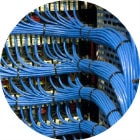What are the key issues that matter to CIOs who are considering a move on-demand and how can they make the most of the cloud?
1 > Be the cloud broker for the business.
Bringing together of systems and services is still a concern for IT leaders considering a move to the cloud. This need for cloud control could lead to a new trend, where expert providers help stabalize management concerns. Moves in this direction are being made. A number of major consultancies and IT providers already tout their expertise in regards to cloud ecosystem management. Yet Peers issues a word of caution to CIOs.
“I see that as the IT leader’s role,” he says. “It’s up to me and my team to act as the broker for these in-house and cloud provided services. We work with the people in the business and help them decide the best place from which to source the solution to our IT challenges.”
Linklaters is using the cloud, for example, across time recording, email filing, and internet and firm-wide security. These developments lead Peers to suggest on-demand can be a crucial tool for CIOs.
“The cloud providers have – in the last 18 months-or-so – realized that security is very important,” he says. “These investments by providers mean we now feel comfortable using these services in certain circumstances. And I see us using more and more on-demand services as the comfort increases.”
2 > Think carefully about performance, cost and vendor lock-in
Never, ever migrate your crown jewels to the cloud (i.e., payment systems & customer databases).
This stance may be in opposition to an increasing number of experts, who believe external cloud providers are often the specialists in security. Cloud providers may argue about this stance but scaling back-end databases on-demand doesn’t usually work well and no CIO should give up the security of crucial information to a 3rd party.
Another key concern when using the cloud, is cost. The cloud works well on a pay-as-you-go basis. but on-demand IT gets expensive when users want to store and use mega-terabytes of data daily.
Small-scale transactional data is perfect for the cloud. When you start having huge databases on-demand, you having to store data on multiple, distributed systems – and that can be difficult & costly to manage. Be careful not to be lured by proprietary technology. Nothing is free. Once you’re locked in, it’s very difficult to migrate away.
3 > Remember the limitations and build a strong case
Toby Clarke, interim head of IT at Moorfields Eye Hospital NHS Foundation Trust, says cloud is “just another IT procurement choice”. “For everything we do now, we consider the cloud,” he says.
Clarke says that, for most organizations, the relationship with the cloud is just going to get bigger and better. However, there will always be important limitations. Moorfields, for example, is not a heavy user of the cloud.
CIOs, he says, must analyze the use of on-demand within the current business context. The hospital has already invested a lot of money in its internal storage array: a move to the cloud would mean the organization needs to pay for two forms of storage – its existing array and on-demand infrastructure.
In addition, the focus on operational expenditure is not right for every CIO. Some executives actually prefer to have fixed costs.
“You might work for an organization that only has capital in its budget for a particular year,” he says. “Cloud, if it simply helps bring down operational costs, doesn’t fit with that funding model. But the cloud has definitely become another platform from which to deliver a technology service in some form or another.”









